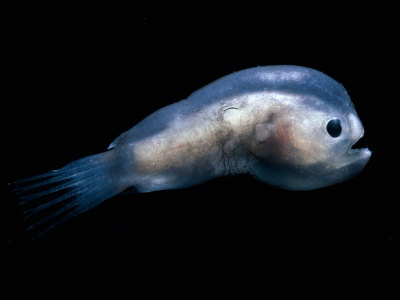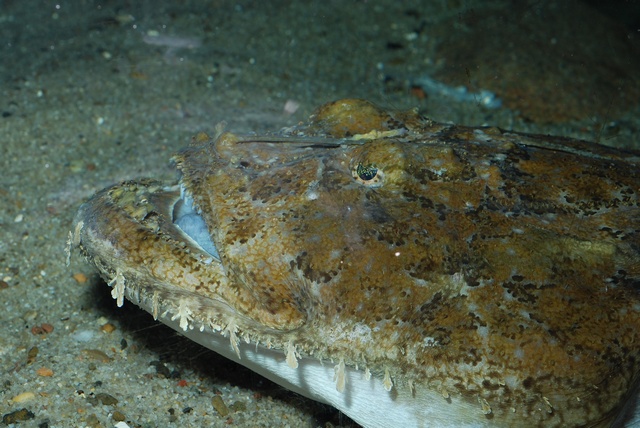The Love Story of an Angler
Finding a mate in the open sea can be very difficult, but with some special adaptations from the very different male and female, anglerfish can successfully reproduce. Beginning in a larval form, Lophius piscatorius grows in a yolk sac for 8-15 days until it hatches (Hislop et. al. 2001). During this time it will develop all necessary structures to survive on its own- a few extras if it happens to be a female. When the larva hatches it looks nearly the same as the mature fish, but it doesn’t have the same abilities or size as the adult (ARKive 2012). The fish will usually float around the pelagic region of the ocean for a couple months or until it can swim on its own. The angler will continue to live in the upper region of the open sea for another couple of months until it is mature enough to spawn (Hislop et. al. 2001). During this immature time in their lives both male and females have transparent gonads (Duarte et. al. 2001).
Once the angler is mature spawning can fin ally
occur. A male anglerfish matures around the age of 4 and grows to be
about 16 inches in length with a white tube- shaped gonad (Duarte
et. al. 2001). Females take 2 years longer to mature and average
about 28 inches possessing an orange band- shaped gonad (Duarte et.
al. 2001)(ARKive 2012). In order for spawning to take place a male
and female anglerfish must first meet up. Although the male angler
may struggle in some aspects of life, he has a vision and a keen
sense of smell that will help him detect the pheromones of any
females in the area. Since he cannot feed on his own it is crucial
that he might find a mate so his large nostrils will come in handy.
The female angler helps the male out with the bioluminescent fishing
rod attached to her head. Once a male detects a female he latches
onto her and eventually fuses with her until he is nothing more than
a pair of gonads. The fusing process begin with the male releasing
an enzyme that “melts” the skin from the male and female anglers
together. The female will use this addition to impregnate herself
whenever the time is right. Sometime between
ally
occur. A male anglerfish matures around the age of 4 and grows to be
about 16 inches in length with a white tube- shaped gonad (Duarte
et. al. 2001). Females take 2 years longer to mature and average
about 28 inches possessing an orange band- shaped gonad (Duarte et.
al. 2001)(ARKive 2012). In order for spawning to take place a male
and female anglerfish must first meet up. Although the male angler
may struggle in some aspects of life, he has a vision and a keen
sense of smell that will help him detect the pheromones of any
females in the area. Since he cannot feed on his own it is crucial
that he might find a mate so his large nostrils will come in handy.
The female angler helps the male out with the bioluminescent fishing
rod attached to her head. Once a male detects a female he latches
onto her and eventually fuses with her until he is nothing more than
a pair of gonads. The fusing process begin with the male releasing
an enzyme that “melts” the skin from the male and female anglers
together. The female will use this addition to impregnate herself
whenever the time is right. Sometime between February and July the
female will travel to deeper waters (500m) to spawn (Linnaeus 1758).
When she is ready to spawn, the female releases a hormone. In
response, the sperm banks attached to her body will release their
sperm and the female will spawn (Doughton 2006). This only happens
one time each season. The females spawn large buoyant sheets of eggs
that will float toward the top of the open ocean (Fariña et. al
2008). To learn more about the sad life of a male Anglerfish click
on this hilarious
comic.
February and July the
female will travel to deeper waters (500m) to spawn (Linnaeus 1758).
When she is ready to spawn, the female releases a hormone. In
response, the sperm banks attached to her body will release their
sperm and the female will spawn (Doughton 2006). This only happens
one time each season. The females spawn large buoyant sheets of eggs
that will float toward the top of the open ocean (Fariña et. al
2008). To learn more about the sad life of a male Anglerfish click
on this hilarious
comic.
Having a permanent sperm bank for reproduction is extremely beneficial for a deep-sea organism like the anglerfish. It is difficult enough for a female angler to find a mate once or twice in her 20-year life span (ARKive 2012). Without both the male and female’s unique adaptations there wouldn’t be very many anglerfish – if any at all today.
Return to Homepage
